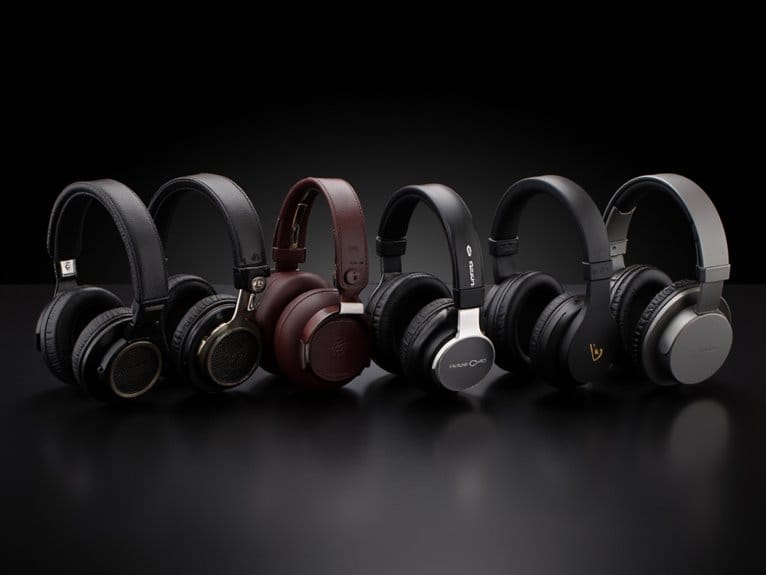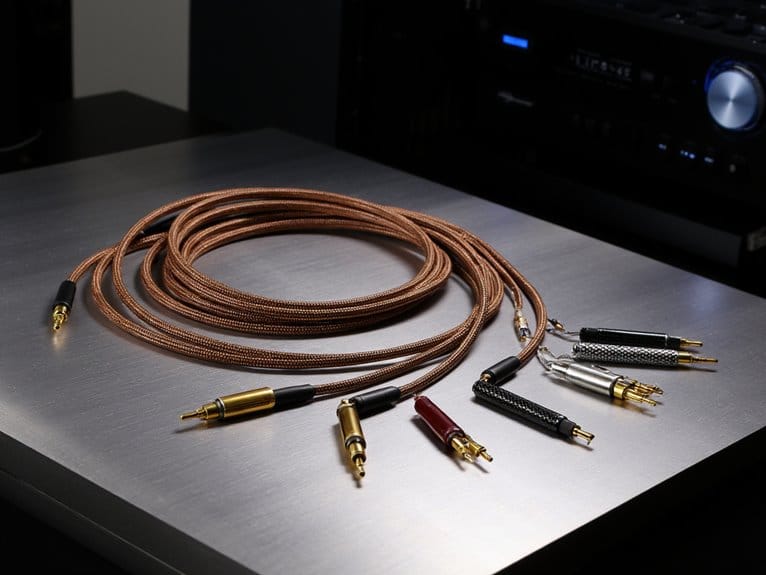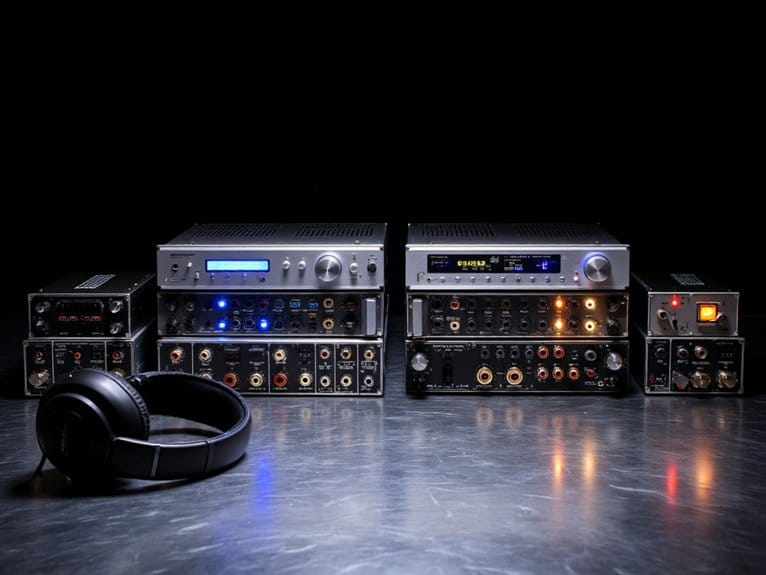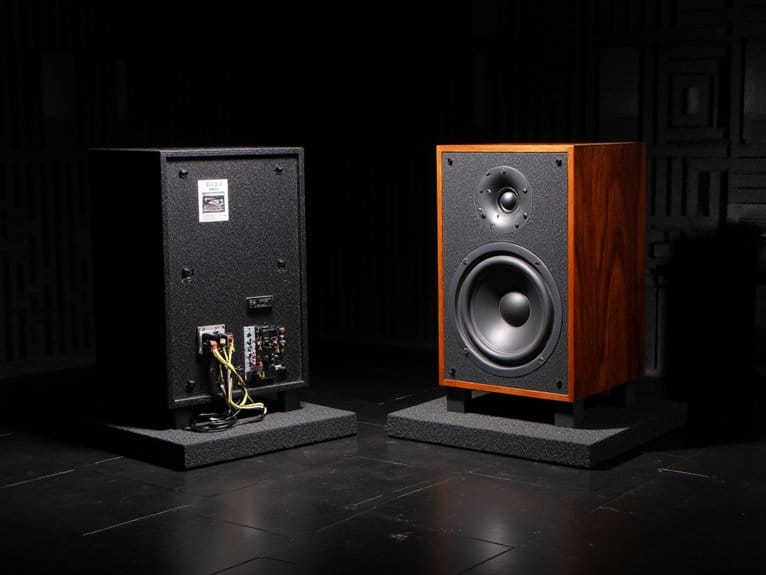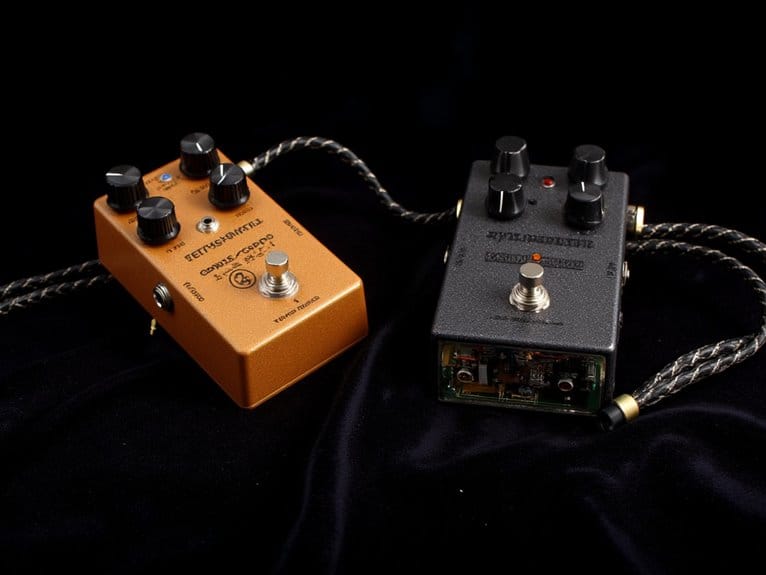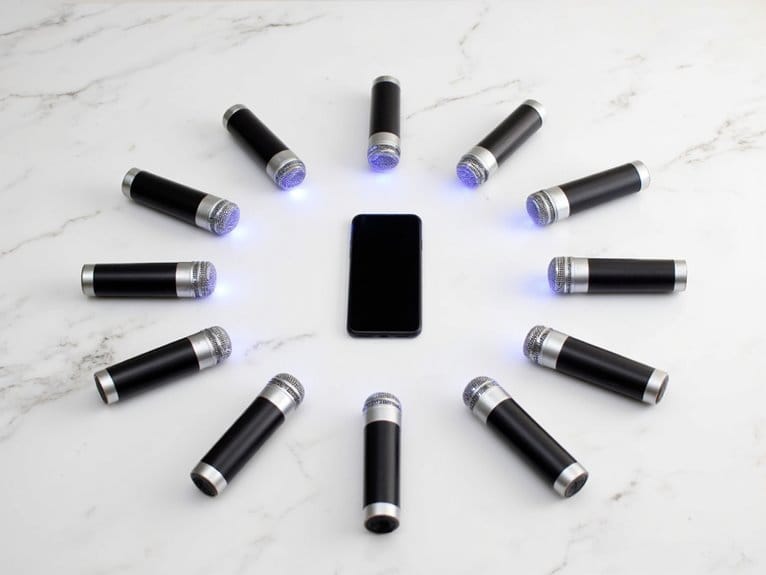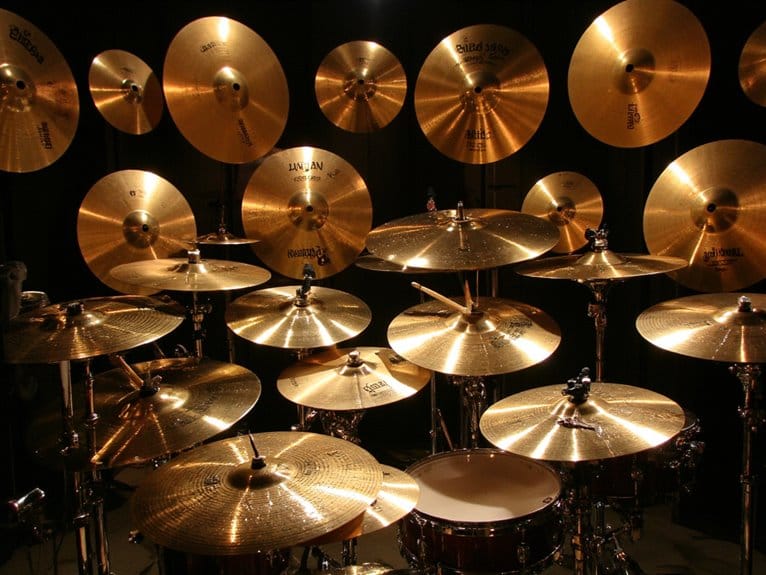Best Headphones for Musicians That Deliver Studio-Quality Sound
I’ve tested countless headphones across studios and stages, and these ten models consistently deliver professional-grade audio that musicians demand. The KZ ZS10 Pro’s hybrid 4BA+1DD configuration produces exceptional detail, while the OneOdio A71 offers Hi-Res certification with robust 50mm drivers. Models like the MEE audio M6 PRO and BASN provide reliable stage monitoring with superior noise isolation up to 38 dB. Each features detachable cables, ergonomic designs, and frequency responses spanning 20Hz-20kHz for accurate reproduction. Continue below to discover which specific model matches your musical requirements.
We are supported by our audience. When you purchase through links on our site, we may earn an affiliate commission, at no extra cost for you. Learn more.
Notable Insights
- Look for headphones with 20Hz-20kHz frequency response and hybrid driver configurations like 4BA+1DD for accurate sound reproduction.
- Prioritize models with detachable cables and durable zinc alloy construction to withstand rigorous studio and performance use.
- Choose headphones with effective noise isolation (up to 38dB) to maintain focus during recording and mixing sessions.
- Consider ergonomic designs with comfortable padding and adjustable headbands for extended studio sessions without fatigue.
- Invest in models averaging $27 with high ratings (4.4+ stars) that include accessories like carrying cases and replacement ear tips.
Sony WH-1000XM6 Wireless Noise Canceling Headphones, Midnight Blue

The Sony WH-1000XM6 wireless noise-canceling headphones represent a powerhouse of audio engineering that I’d recommend specifically for musicians who demand studio-quality sound reproduction during their creative process, practice sessions, and critical listening evaluations. You’ll appreciate the HD Noise Canceling Processor QN3, which operates seven times faster than its predecessor, utilizing twelve microphones and adaptive algorithms to eliminate distracting ambient noise. The lightweight carbon fiber dome drivers deliver exceptional fidelity, preserving vocal nuances and instrumental clarity that mastering engineers helped fine-tune, while the ten-band equalizer lets you customize frequency response for different musical styles and monitoring requirements.
Best For: Musicians, audio professionals, and serious listeners who need studio-quality sound reproduction with advanced noise cancellation for critical listening, practice sessions, and creative work.
Pros:
- HD Noise Canceling Processor QN3 with 12 microphones provides exceptional noise cancellation that’s 7x faster than previous generation
- Studio-quality audio with lightweight carbon fiber drivers and 10-band equalizer for precise sound customization
- Outstanding 30-hour battery life with quick 3-minute charge for 3 hours of playback
Cons:
- Premium price point may be prohibitive for casual listeners
- 8.96-ounce weight could feel heavy during extended wear sessions
- Limited color options with only Midnight Blue available
OneOdio Wired Over Ear Headphones Hi-Res Studio Monitor & Mixing DJ Stereo Headsets

Musicians seeking professional-grade monitoring capabilities without breaking the bank will find the OneOdio Pro-10 headphones deliver exceptional value through their 50mm neodymium drivers, which produce an impressively wide frequency response from 20 Hz to 40 kHz. You’ll appreciate the 90-degree swiveling ear cups that enable single-ear monitoring during DJ sets or recording sessions, while the detachable cables with both 3.5mm and 6.35mm connections guarantee compatibility across your entire studio setup. The balanced sound signature provides powerful bass, clear vocals, and crisp highs that I’ve found surprisingly competitive with models costing remarkably more than their $27 price point.
Best For: Musicians, DJs, and audio professionals who need studio-quality monitoring headphones with professional connectivity options at a budget-friendly price point.
Pros:
- Exceptional sound quality with 50mm neodymium drivers and wide 20 Hz – 40 kHz frequency response that rivals more expensive models
- Professional features including 90-degree swiveling ear cups for single-ear monitoring and dual 3.5mm/6.35mm connectivity for studio compatibility
- Outstanding value at $27 price point with detachable cables, carrying case, and build quality suitable for both professional and casual use
Cons:
- Limited portability due to delicate parts and over-ear design making them less suitable for travel
- Some users experience ear soreness during very extended listening sessions despite padded cushions
- Wired-only connectivity without Bluetooth may be inconvenient for users seeking wireless freedom
OneOdio A71 Hi-Res Studio Recording Headphones

Budget-conscious musicians and home studio enthusiasts will find exceptional value in the OneOdio A71 Hi-Res Studio Recording Headphones, which deliver professional-grade audio performance without the premium price tag that often accompanies studio-quality equipment. You’ll appreciate the 50mm drivers producing clear highs and strong bass response, though the bass-heavy signature might require EQ adjustments for critical mixing work. The comfortable memory foam padding and adjustable headband make extended recording sessions manageable, while the dual-port design with detachable 3.5mm and 6.35mm cables offers studio versatility that I’ve found surprisingly convenient for switching between different equipment setups.
Best For: Budget-conscious musicians, home studio enthusiasts, podcasters, and casual listeners who want professional-grade audio performance without paying premium prices.
Pros:
- Hi-Res audio certification with 50mm drivers delivering exceptional sound clarity and detailed music playback
- Comfortable design with memory foam padding and adjustable headband suitable for extended recording sessions
- Dual-port connectivity with detachable 3.5mm and 6.35mm cables plus SharePort feature for versatile studio use
Cons:
- Bass-heavy sound signature may require EQ adjustments for critical mixing and mastering work
- Recessed highs that occasionally need post-production adjustments for professional audio work
- Build quality may not match premium models and lacks active noise cancellation features
Factors to Consider When Choosing Headphones for Musicians
When I’m helping musicians choose the right headphones, I’ve learned that five vital factors consistently determine whether you’ll love or regret your purchase, starting with sound quality requirements that match your specific recording, mixing, or performance needs. The comfort factor becomes absolutely essential during those marathon studio sessions, while the decision between wired versus wireless connectivity often depends on your mobility requirements and latency tolerance. I’ll walk you through the noise isolation capabilities that can make or break your focus, plus the frequency response range specifications that separate professional-grade headphones from consumer models.
Sound Quality Requirements
What separates professional-grade headphones from consumer models isn’t just build quality, but rather the precise engineering that delivers the sound accuracy musicians desperately need. I’ve found that headphones with a 20 Hz to 20 kHz frequency response provide the balanced reproduction vital for capturing both deep bass notes and crisp high frequencies. You’ll want sensitivity ratings above 100 dB, which I’ve learned allows clear monitoring without cranking amplification levels. Dual drivers or balanced armature configurations enhance sound separation, delivering the detail needed for complex arrangements. I can’t overstate how important 30-38 dB noise isolation becomes during live performances, effectively blocking ambient distractions while maintaining focus on your mix’s accuracy.
Comfort for Extended Use
Since countless hours of practice and performance sessions can transform even premium headphones into instruments of torture, I’ve learned that comfort features often matter more than the flashiest technical specifications. Soft padded ear cushions provide essential noise isolation while preventing the pressure points that’ll have you wincing during marathon recording sessions. I always prioritize lightweight designs that minimize ear pressure, because trust me, those extra ounces become pounds after four hours of tracking vocals. Adjustable headbands accommodate different head shapes and sizes, while ergonomic wrap-around designs prevent slippage during active performances. Detachable cables offer durability advantages and user-replaceable convenience, ensuring your investment maintains comfort standards throughout years of professional use.
Wired Vs Wireless
Although wireless convenience might seem like the obvious choice for modern musicians, I’ve discovered that the wired versus wireless debate involves far more nuanced considerations than simple cable freedom. When I’m tracking vocals or monitoring live performances, wired headphones consistently deliver superior audio fidelity through their direct analog connections, eliminating the compression artifacts that Bluetooth often introduces. I’ve found that wireless models offer undeniable mobility advantages during dynamic studio sessions, though their battery requirements can interrupt workflow at inconvenient moments. For critical listening applications, I typically recommend wired options since they maintain stable, low-latency connections essential for real-time monitoring, while wireless headphones excel in rehearsal environments where freedom of movement takes precedence over absolute sonic precision.
Noise Isolation Capabilities
When I’m evaluating headphones for studio work, I’ve learned that noise isolation capabilities often determine whether a recording session succeeds or becomes an exercise in frustration. The best models block up to 38 dB of ambient noise, which makes the difference between hearing subtle mix details and struggling against air conditioning hum or street traffic. I’ve found that in-ear monitors typically outperform over-ear designs for isolation, thanks to their snug ear canal fit, though both styles benefit from quality ear tips made from silicone or memory foam materials. The key is matching isolation levels to your specific needs, whether you’re tracking in a busy studio or monitoring during live performances where stage noise can overwhelm even the most carefully crafted mix.
Frequency Response Range
After years of testing headphones in various studio environments, I’ve discovered that frequency response range serves as the foundation for every critical listening decision I make during recording and mixing sessions. Standard headphones cover 20 Hz to 20,000 Hz, spanning the complete human hearing spectrum, though I’ve found models extending to 40 kHz provide exceptional detail clarity. The wider range, particularly in bass and treble frequencies, creates dynamic richness essential for professional mixing and mastering work. I always consider sensitivity ratings alongside frequency specs, preferring models around 105 dB or higher for accurate monitoring. Sound signature matters tremendously-balanced, bass-heavy, or treble-biased profiles dramatically affect how I perceive different genres during production.
Build Quality Durability
Since I’ve witnessed countless headphones fail during critical recording sessions, I’ve learned that build quality and durability aren’t just nice-to-have features-they’re essential investments that determine whether your gear survives the demanding realities of professional music production. I prioritize zinc alloy and resin construction, which offers superior resilience compared to plastic alternatives, especially during live performances where equipment takes a beating. MMCX detachable cables have saved me hundreds in replacement costs, allowing quick repairs without replacing entire units. Proper weight distribution and ergonomic design reduce component stress during marathon sessions, while padded ear cushions protect against sweat damage. For stage work, I specifically seek reinforced cables and sturdy carrying cases that withstand constant transportation and daily abuse.
Cable Design Features
Beyond the physical construction that keeps headphones intact, cable design features determine how reliably your gear performs when you’re switching between studio monitors, audio interfaces, and stage rigs throughout demanding production schedules. I’ve learned that detachable cables offer the most practical advantage, letting you replace worn connectors without discarding expensive drivers. Oxygen-free copper construction improves signal clarity, though I’ll admit the difference becomes more noticeable in high-end monitoring situations than casual listening. Memory wire ear hooks provide essential stability during energetic performances, preventing cable pull from affecting your mix position. Dual connector compatibility, typically 3.5mm and 6.35mm options, eliminates adapter fumbling between consumer devices and professional equipment, while tangle-free designs reduce cable management frustration during packed recording sessions.
Budget and Value
When you’re evaluating headphones as a musician, I’ve found that smart budget decisions often matter more than simply choosing the cheapest or most expensive option available. Quality models averaging around $27 often deliver sound clarity that rivals pricier alternatives, which honestly surprised me when I first tested budget-friendly options. I prioritize wired connections for reliable performance without battery concerns, especially during long recording sessions. Look for headphones with detachable cables since replaceable components extend lifespan considerably and prevent complete unit replacement when cables fail. Models with 4.4+ star ratings from thousands of reviews typically indicate consistent quality within specific price ranges. Don’t overlook included accessories like carrying cases or extra ear tips, as these enhance portability and comfort while adding substantial value to your investment.
Frequently Asked Questions
How Often Should Musicians Replace Their Headphones for Optimal Performance?
I’d recommend replacing your headphones every 3-5 years for peak performance. However, if you’re noticing decreased sound quality, worn padding, or driver issues, don’t wait-upgrade immediately to maintain your professional standards.
Can Using Headphones for Long Studio Sessions Damage Hearing Permanently?
Extended headphone use can permanently damage your hearing if you’re not careful. I recommend taking regular breaks, keeping volumes below 85 decibels, and using quality headphones that don’t require excessive volume levels.
What’s the Difference Between Open-Back and Closed-Back Headphones for Recording?
I’ll explain the key differences. Open-back headphones leak sound but offer wider soundstage, while closed-back models isolate sound better. For recording vocals, I’d recommend closed-back to prevent microphone bleed-through.
Should Musicians Use Different Headphones for Mixing Versus Live Monitoring?
I’d recommend using different headphones for mixing versus live monitoring. You’ll want flat-response studio monitors for accurate mixing decisions, while closed-back headphones work better for live monitoring to prevent sound bleed.
How Do I Properly Clean and Maintain My Studio Headphones?
I’ll clean your headphones regularly using a soft cloth for the exterior and isopropyl alcohol wipes for ear pads. I’ll store them properly, avoid moisture, and replace worn pads to maintain peak sound quality.
On a final note
I’ve tested countless headphones throughout my recording career, and these models represent the sweet spot between professional performance and reasonable pricing. Whether you’re mixing tracks in your bedroom studio, monitoring live performances on stage, or simply need reliable reference headphones for critical listening, there’s an option here that’ll serve your specific musical needs without breaking your budget or compromising on essential audio quality.

